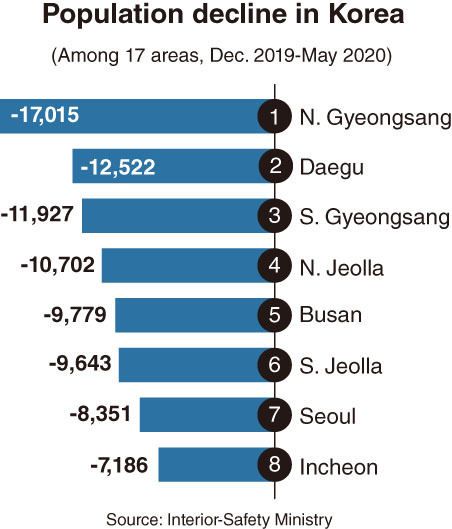[News Focus] 4 major cities lose 37,000 residents since Dec. 1
Deaths exceed births in Korea for 7 consecutive months
By Kim Yon-sePublished : June 9, 2020 - 13:17

SEJONG -- South Korea’s four largest cities saw significant population declines over the past six months, depressing the population of the nation as a whole.
The collective population of Seoul, Busan, Incheon and Daegu declined by 37,838 during the period beginning December 2019 and ending May 2020, according to data from the Ministry of Interior and Safety.
Daegu’s population fell by 12,522, the steepest decline among the four cities. Alongside neighboring North Gyeongsang Province, the southeastern city has seen sharp negative population growth from month to month.
Busan saw the next-steepest decline in population, losing 9,779 registered residents, whereas Seoul lost 8,351 and Incheon 7,186.
The situation was similar in the metropolitan cities of Daejeon, which posted a population growth figure of minus 5,040; Gwangju, which saw minus 3,382; and Ulsan, which saw minus 5,774.
For the seven major cities combined, the number of residents declined by 52,034 over the six-month period.
Among Korea’s nine provinces, North Gyeongsang Province recorded the largest drop, losing 17,015 residents. This was also the biggest population decline among the 17 major regions across the nation.

South Gyeongsang Province posted minus 11,927, trailed by North Jeolla Province with 10,702, South Jeolla Province with 9,643, South Chungcheong Province with 5,792 and North Chungcheong Province with 2,941.
Gangwon and Jeju provinces also saw their populations decline -- by 2,760 and 102, respectively.
Only two of the country’s 17 regional divisions posted positive population growth during the period: Gyeonggi Province gained 95,864 residents for an all-time high of 13.32 million, and Sejong gained 6,726 for a high of 345,373.
Overall, Korea’s population decreased 10,326 over the period.
The unprecedented fall is attributed to the record-low fertility rate of less than 1 during those six months. The fertility rate refers to the average number of children a woman bears in her lifetime. Also, during the six-month period deaths exceeded births, 156,891 vs. 143,724, for a difference of 13,167.
The monthly demographic data reflects not only the number of births and deaths, but also changes in citizenship and long-term residency status for Koreans residing overseas and foreigners residing here. Those changes offset the lower fertility rate and the birth and death statistics to some extent. Because some Koreans renounced their citizenship or became long-term residents overseas, and some foreigners acquired Korean citizenship or long-term residency here, the total population declined by only 10,326.
“Deaths outnumbered births for the seventh consecutive month, starting from November,” said a government official. “The reversal situation in birth and death would aggravate the ongoing seriousness, in which the percentage of working age population (aged 15-64) had already been declining.”
The working-age population stood at 71.8 percent of the total last month, compared with 72.3 percent a year earlier, according to the Interior Ministry. It was the lowest figure in at least 12 years, since the government officially started compiling the data in January 2008.
The working-age population, which peaked at 73.4 percent in January 2012, has continued to slide over the past eight years and particularly the past four. It hit 73.2 percent in April 2016, 72.9 percent in April 2017, 72.6 percent in April 2018 and 72.3 percent in April 2019.
Korea recorded a fertility rate of 1.654 in 1993, when the government started compiling official statistics. That level, though relatively low, was still enough to ensure a sustainable working-age population. Korea’s fertility rate is estimated to have surpassed 2 in the early 1980s and 4 in the early 1970s.
But the fertility rate continued to decline in the 1990s and 2000s and posted 1.187 in 2013. The figure for 2018 was 0.977, below the 1 mark for the first time in history, and hit 0.92 in 2019, Statistics Korea data showed.
By Kim Yon-se (kys@heraldcorp.com)


![[Exclusive] Korean military set to ban iPhones over 'security' concerns](http://res.heraldm.com/phpwas/restmb_idxmake.php?idx=644&simg=/content/image/2024/04/23/20240423050599_0.jpg&u=20240423183955)




![[Pressure points] Leggings in public: Fashion statement or social faux pas?](http://res.heraldm.com/phpwas/restmb_idxmake.php?idx=644&simg=/content/image/2024/04/23/20240423050669_0.jpg&u=)

![[Herald Interview] 'Amid aging population, Korea to invite more young professionals from overseas'](http://res.heraldm.com/phpwas/restmb_idxmake.php?idx=644&simg=/content/image/2024/04/24/20240424050844_0.jpg&u=20240424200058)








